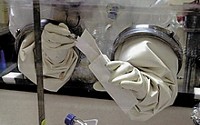Advertisement
Grab your lab coat. Let's get started
Welcome!
Welcome!
Create an account below to get 6 C&EN articles per month, receive newsletters and more - all free.
It seems this is your first time logging in online. Please enter the following information to continue.
As an ACS member you automatically get access to this site. All we need is few more details to create your reading experience.
Not you? Sign in with a different account.
Not you? Sign in with a different account.
ERROR 1
ERROR 1
ERROR 2
ERROR 2
ERROR 2
ERROR 2
ERROR 2
Password and Confirm password must match.
If you have an ACS member number, please enter it here so we can link this account to your membership. (optional)
ERROR 2
ACS values your privacy. By submitting your information, you are gaining access to C&EN and subscribing to our weekly newsletter. We use the information you provide to make your reading experience better, and we will never sell your data to third party members.
Policy
Experts Discuss The Threat Posed By Ricin
Most terrorism efforts with the protein toxin are amateurish, experts say, but it is still a potent agent
by William G. Schulz
May 20, 2013
| A version of this story appeared in
Volume 91, Issue 20

An arrest in the case of the ricin-laced letters that were mailed to various politicians, including President Barack Obama, in Washington, D.C., at the end of April appears to have quieted alarm about the assaults—at least for now. The ricin scare is likely to resurface many times over as the Federal Bureau of Investigation makes its case against the suspect now in custody.
The FBI investigation apparently targeted the wrong suspect at first, but the bureau now claims to have its man. He is 41-year-old James Everett Dutschke, the owner of a taekwondo facility in Tupelo, Miss. He was arrested on April 27. Evidence of ricin production—the toxin is derived from castor beans—was found in his home and martial arts studio. In the letters that showed up in Washington, the ricin had been ground into fine particles meant to be inhaled or absorbed through the skin.
But questions linger. How did Dutschke obtain ricin or learn how to make it? How did he mill or weaponize the toxin? Was the job professional or amateurish? Why didn’t anyone get sick? And if Dutschke is guilty, did he have help?
When ricin is highly purified and administered by its optimal mode of delivery, injection, it is a deadly chemical weapon. After injection, inhalation of ricin particles is the next most effective means of poisoning. Along with purity of the material, however, the quality of the milled particles is a controlling factor. They must be fine enough that they are easily suspended in the air where they can be breathed in sufficient quantity by the victim. Dermal absorption is almost never effective. Instead, contact with ricin on the hands could be transferred internally by handling and ingesting food.
Derived from a biological source, the toxin cannot replicate in the body the way that, for example, anthrax can, and it cannot spread person to person. The Centers for Disease Control & Prevention (CDC) lists ricin as a B agent, meaning it is moderately easy to make and disseminate, and it has a moderate rate of morbidity and mortality. For these reasons, police, national security, and counterterrorism investigators have long worried about ricin attacks.
Ricin is “a complex protein, a very large protein,” says John Troyer, vice president of chemical defense product development at PharmAthene. Ricin is a hardy protein, he adds, that will nonetheless break down under certain environmental conditions, such as heat and moisture. Right now there is no treatment for ricin poisoning, Troyer and others say.
Subunits of the ricin protein enter a cell via the thiol-disulfide exchange mechanism and then proceed to shut down the ribosome, which manufactures the body’s needed proteins, explains David A. Sanders, a Purdue University structural biologist. Ricin poisoning causes severe diarrhea, and victims die of organ failure that results as the toxin spreads throughout a person’s body.
Although people can survive a ricin attack, Sanders says, concentrated doses of highly pure agent will almost certainly cause death and there is no way to stop the body’s cellular machinery from shutting down. “Once ricin is in the cell, you can’t do much,” Sanders explains. Some palliative measures can be given to victims, he notes, such as ingestion of activated charcoal to attempt to remove poison from the body.
If Dutschke made ricin, how he went about it, including grinding it into a powder, is of prime interest to investigators and others. This information will be paramount to the FBI case against Dutschke, but it will also provide insight for those who study such incidents for clues as to what knowledge and practices are currently circulating among evildoers.
The FBI, however, is not likely to release specific details about its investigation, at least not while Dutschke is being arraigned and is making preliminary court appearances. National security officials are also cautious about releasing information that could inspire copycat crimes or spread knowledge of how to weaponize ricin.
Likewise, experts say the FBI will probably not reveal its methods for determining the presence of ricin. But CDC says that to test for ricin, in general, it first uses a time-resolved immunofluorescence assay to look for traces of the protein and then uses further techniques, including polymerase chain reaction amplification of residual castor bean DNA that codes for ricin protein, to confirm the presence of ricin and eliminate false positives from assay cross-reactivity with other biological molecules.
Laboratory methods to make highly pure ricin toxin do exist. Biosecurity expert Gary Cecchine of the RAND Gulf States Policy Institute notes that at least one method for ricin extraction was patented by chemists in 1962 (U.S. Patent 3,060,165). RAND is a nonprofit institute that provides research services as a government contractor. Not all of the reasons for developing these extraction methods relate to chemical weaponry. A modified ricin compound has been considered for testing as an anticancer agent, he says.
But a basic extraction and preparation of ricin is not difficult and can be accomplished with such items as a coffee grinder. Cecchine says plenty of ricin-making recipes are available on the Internet; fortunately, none of them are very good. “We are happy to have those around,” he says, because people looking to do harm who use them generate a weak poison, which is not likely to kill anybody.
“I call it a weapon of mass disruption,” Cecchine says of ricin. An attack will rightfully frighten people and trigger preventive measures such as building closures. He cites two incidents in 2004, thought to be related, in which ricin was sent to the White House and the Dirksen Senate Office Building. No one was injured, but the attacks closed the Senate building for a time.
“I can’t think of a case of ricin poisoning that wasn’t done by amateurs,” Cecchine says. “It’s not easy to mill ricin to the right particle size” for use as a weapon without expensive machines. Efforts to obtain the right equipment, he adds, would alert authorities.
Sanders, who also works with many of the world’s deadliest viruses, such as Ebola, says he hopes the recent scare will not result in a call from Congress or other officials to ramp up ricin research. It is an agent scientists know a lot about, he says, and the recent poisoning attempts don’t justify spending money and talent to learn more about it. Besides, he says, when research programs on deadly agents are expanded, one result is to increase the number of people who are expert in producing weapons-grade agents.
The FBI knows all about that scenario: Army researcher Bruce E. Ivins, who worked with anthrax, killed himself after the bureau named him as the prime suspect in the 2001 anthrax attacks on New York City; Washington, D.C.; and Florida. Anthrax-laced letters killed five people and sickened many more. Several years after Ivins’ death, the FBI concluded he was the sole culprit and closed the case.
Sanders points out that Ivins had been involved in a much-criticized Army effort to produce an anthrax vaccine. If one accepts the FBI’s verdict on the anthrax case, Sanders says, then one can surmise that a disgruntled Ivins might have used his expertise to prove the terrible point that the U.S. needs an anthrax vaccine.
As the recent ricin attacks move into and out of news headlines, which is bound to happen as the case plays out, Sanders cautions, “we should not overreact.”




Join the conversation
Contact the reporter
Submit a Letter to the Editor for publication
Engage with us on Twitter